
Earthquake Resistant Systems: Safe Buildings of the Future
Earthquakes are one of the most common natural disasters around the world, and the earthquake resistance of structures is of critical importance to ensure the safety of life and property.
1. Engineering Design and Building Materials: The basis of earthquake-resistant systems is engineering design and correct building materials. Materials such as high-strength concrete, steel frames, and flexible adhesives make structures resistant to earthquakes.
2. Settlement and Soil Analysis: Soil and settlement analyzes are very important to build an earthquake-resistant structure. These analyzes evaluate the geological structure and earthquake potential of the region where the building is located and ensure that appropriate measures are taken.
3. Screw Locking and Isolation Technologies: One of the methods used to strengthen structures against earthquakes is screw locking and isolation technologies. These technologies minimize damage by protecting the structure from shocks.
4. Seismic Beams and Ductile Structures: Seismic beams make the building more flexible during an earthquake. Ductile structures, on the other hand, allow building elements to flex and absorb energy during an earthquake.
5. Smart Sensors and Monitoring Systems: Smart sensors and monitoring systems accelerate damage detection by constantly monitoring the post-earthquake status of structures. In this way, rapid intervention and repairs can be carried out.
6. Social Awareness and Education: Social awareness and education are of great importance for earthquake-resistant systems to be effective. Building users should know how to act safely during an earthquake and be prepared for post-earthquake processes.
Earthquake-resistant systems are becoming stronger today with the combination of engineering and technology. These developments in the construction sector allow us to take important steps in minimizing the damage caused by earthquakes and ensuring human safety. However, the effectiveness of these systems can be increased depending on factors such as social awareness, correct design and regular maintenance.





